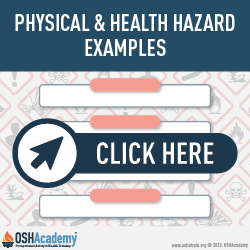Hazardous Substances and Chemicals
OSHA defines a substance as a chemical element and its compounds in the natural state or obtained by any production process.
This definition includes any additive necessary to preserve the stability of the product and any impurities deriving from the process used, but excludes any solvent which may be separated without affecting the stability or altering the composition of the substance.
Hazardous Substances: OSHA defines a "hazardous substance" as any chemical or material which is a physical hazard or a health hazard. They are subject to specific regulatory thresholds and reporting requirements.
- Physical hazards include chemicals and materials that can cause physical harm by being flammable, explosive, reactive, or corrosive.
- Health hazards include chemicals or materials that can cause acute or chronic health effects including irritation, cancer, neurotoxicity, and agents that damage the blood-forming organs, lungs, skin, eyes, or mucous membranes.
Hazardous Chemicals: OSHA defines a "hazardous chemical" as any chemical which is classified as a physical hazard, health hazard, simple asphyxiant, combustible dust, pyrophoric gas, or hazard not otherwise classified.
Below is a list of examples of hazardous chemicals.
Physical Hazards:
- explosives
- flammables (gases, aerosols, liquids, or solids)
- oxidizers (liquid, solid or gas)
Health Hazards:
- acute toxicity (any route of exposure)
- respiratory or skin sensitization
- specific target organ toxicity (single or repeated exposure)
Asphyxiants:
- carbon monoxide
- nitrogen
- helium
- argon
Pyrophoric Gases:
- silane
- arsine
- phosphine
- germane
- diborane
- trimethylaluminum
- diethylzinc
- stibine
Real-Life Accidents
Knowledge Check Choose the best answer for the question.
1-3. Under the HCS, what is an example of a physical hazard?
You forgot to answer the question!

